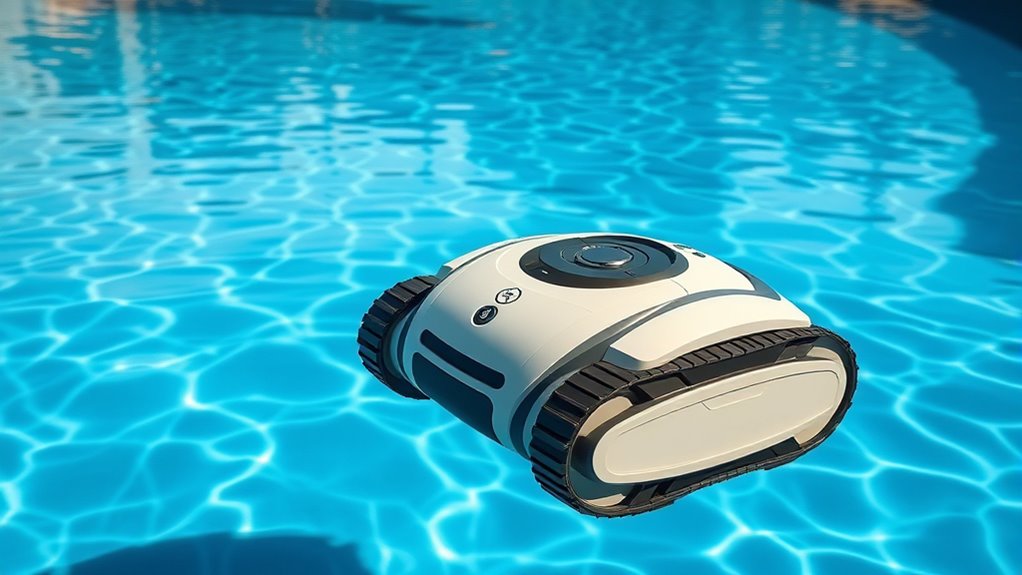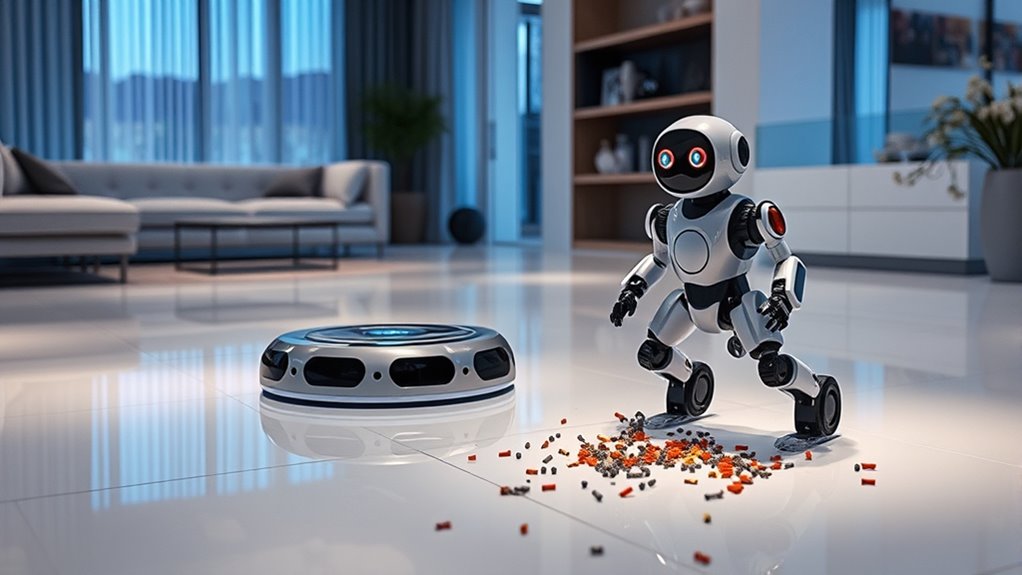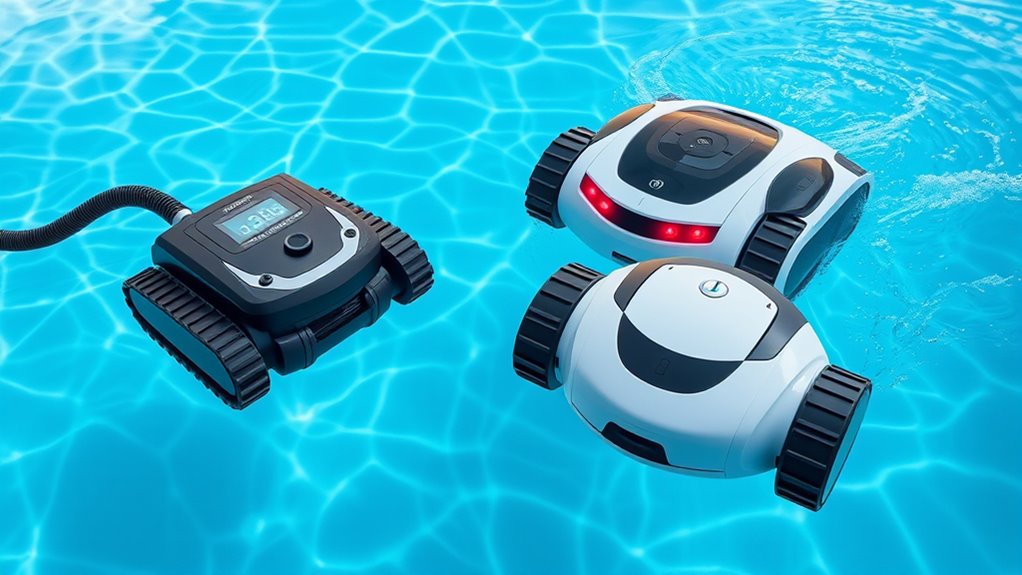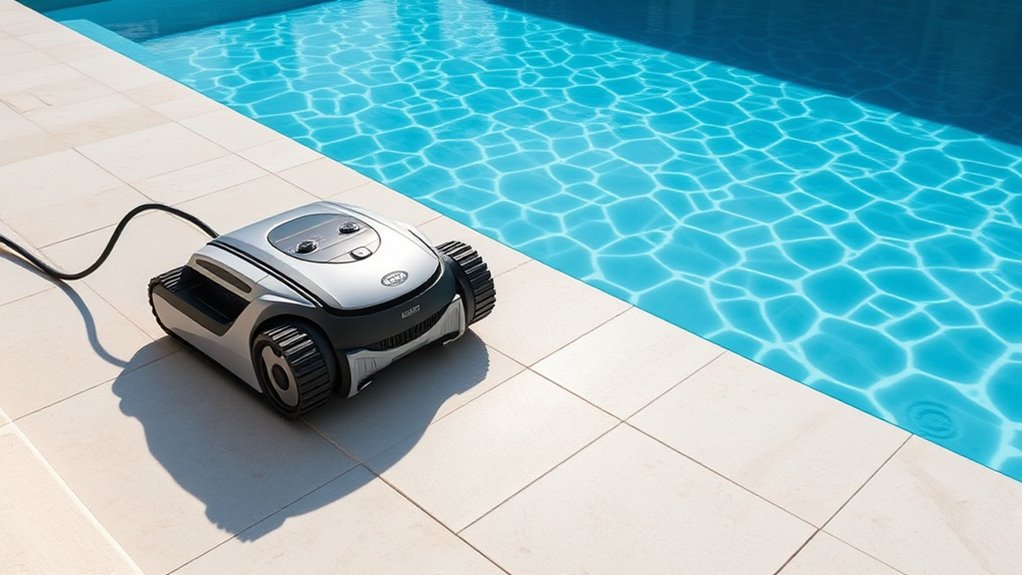Robotic pool cleaners are quickly overtaking traditional suction models due to advancements in technology, efficiency, and ease of use. They offer better coverage, smarter navigation, and remote control features, making them more popular among consumers. As market trends favor automation and smart devices, robotic cleaners are becoming the preferred choice for many. To discover how these trends impact your options and why robots are gaining ground, keep exploring further.
Key Takeaways
- Robotic pool cleaners are increasingly favored for their superior coverage and autonomous operation, surpassing manual suction cleaners.
- Market trends show rising consumer demand for smart, automated solutions, leading to greater adoption of robotic models.
- Robotic cleaners offer long-term savings and efficiency benefits that often justify their higher initial cost over traditional suction devices.
- Technological advancements like AI, smart navigation, and app control are accelerating the shift toward robotic pool cleaning systems.
- Overall industry growth indicates that robotic cleaners are gradually overtaking suction models as the preferred pool cleaning technology.
Overview of Pool Cleaning Technologies

Pool cleaning technology has evolved considerably, offering a variety of options to keep your pool spotless. You now have tools that simplify pool surface maintenance, such as manual skimmers and automatic cleaners. Chemical balancing techniques are also essential, ensuring the water stays safe and clear. Traditional methods involve regular chemical tests and adjustments, but modern systems integrate sensors for real-time monitoring. Some devices combine surface cleaning with chemical management, reducing your effort. While suction pool cleaners have been popular for their reliability, robotic cleaners are gaining traction due to advanced features like programmable schedules and thorough coverage. These automated systems often feature smart navigation and customizable cleaning cycles, making maintenance more efficient and less time-consuming. Additionally, sensor technology plays a crucial role in detecting water quality issues early, improving overall pool maintenance. The integration of advanced navigation algorithms enables robotic cleaners to optimize their cleaning paths, ensuring more comprehensive coverage. Moreover, the incorporation of artificial intelligence allows these devices to adapt to different pool shapes and obstacles, enhancing their effectiveness. Overall, these innovations make pool upkeep more efficient, allowing you to maintain crystal-clear water with less hassle. Speaks 4 Me Online offers insights into trending voiceover styles that can also enhance your brand communication.
Market Growth of Robotic Pool Cleaners

Robotic pool cleaners are experiencing rapid market expansion, driven by their advanced technology and convenience. As more consumers recognize their benefits, adoption rates continue to climb steadily. This growth signals a significant shift in how people maintain their pools today. Additionally, the integration of smart features in these devices allows for even more efficient and personalized cleaning experiences. Moreover, the increasing availability of wireless connectivity in household devices further enhances their usability and integration into smart home systems. Furthermore, this trend reflects a broader movement towards technological adaptability in household devices, making maintenance easier and more accessible for consumers. The market influence of entertainment industries in shaping consumer preferences and technological adoption also plays a role in accelerating this trend. As the market develops, innovations like energy monitoring and remote control capabilities are expected to become standard, further revolutionizing pool maintenance.
Market Expansion Trends
As consumer interest in automated cleaning solutions continues to grow, the market for robotic pool cleaners is experiencing significant expansion. You’ll notice this shift as manufacturers introduce more models with advanced features, fueling increased competition. Despite the risk of market saturation, brands are focusing on offering competitive pricing to attract new customers and stand out. This strategy helps expand the market reach beyond early adopters, encouraging broader adoption. As a result, prices are becoming more accessible, making robotic pool cleaners a viable option for a wider audience. The ongoing innovation and affordability drive the market’s upward trajectory, signaling sustained growth. If you’re considering investing in this space, expect continued diversification and competitive dynamics shaping the future of robotic pool cleaner sales.
Consumer Adoption Rates
Consumer adoption rates for robotic pool cleaners are accelerating as more homeowners recognize their convenience and efficiency. Advances in smart home integration allow these devices to sync seamlessly with other home systems, making operation simpler and more intuitive. Improved user interfaces mean you can control and customize cleaning schedules with just a few taps, enhancing overall usability. As these features become standard, more people feel confident in switching from traditional suction pool cleaners to robotic models. Additionally, educators and early adopters share positive experiences, further boosting adoption. The combination of smarter technology and better user experiences fuels rapid growth in the market. Moreover, the increasing availability of new products for sale provides consumers with more options and competitive pricing, encouraging wider adoption. The rise of sustainable and eco-friendly designs also appeals to environmentally conscious consumers looking to reduce their ecological footprint. If you’re considering an upgrade, now’s the time to explore robotic pool cleaners that fit your lifestyle and elevate your pool maintenance routine.
Performance Comparison: Robots vs. Suction Cleaners

While both suction pool cleaners and robotic systems aim to keep your pool spotless, their performance varies considerably. Suction cleaners rely on your pool’s filtration system, which means they often require manual cleaning and regular maintenance to remove clogs and debris buildup. This can lead to maintenance challenges and inconsistent cleaning results, especially in larger or more complex pools. In contrast, robotic pool cleaners operate independently, maneuvering automatically and covering surfaces more thoroughly. They don’t depend on manual intervention as much and typically offer better coverage, resulting in a cleaner pool with less ongoing effort from you. However, robotic systems tend to be more expensive upfront and may require periodic maintenance of their own components. Overall, robotic cleaners generally outperform suction models in efficiency and ease of use.
Cost Analysis and Value Proposition

You’ll notice that suction pool cleaners often cost less upfront, but robots tend to offer better long-term value through durability and advanced features. Price trends show a widening gap, making initial investment a key consideration. Additionally, digital literacy programs can aid in understanding and maintaining these technological devices effectively. Being familiar with appliance maintenance plans can also help in ensuring the longevity of your pool cleaning equipment. Moreover, understanding home decor principles can enhance the overall aesthetic appeal of your pool area, creating a more inviting outdoor space. Incorporating knowledge about Kia Tuning techniques, such as suspension upgrades or ECU remapping, can provide insights into optimizing other vehicle-related investments, including pool equipment maintenance or outdoor setups. Additionally, understanding the benefits and side effects of juice detox routines can complement your outdoor lifestyle by promoting health and vitality during poolside activities.
Price Comparison Trends
When comparing suction pool cleaners and robotic pool cleaners, price differences often reflect their features and performance levels. Suction cleaners typically have lower upfront costs, aligning with straightforward pricing strategies focused on affordability. Robotic cleaners, however, tend to be more expensive, justified by advanced technology, smarter navigation, and additional features. An exhaustive analysis reveals that suction models are budget-friendly options for basic cleaning needs, while robotic models offer more comprehensive cleaning with higher initial investment. Market trends show that consumers are increasingly willing to pay a premium for robotic cleaners due to their convenience and efficiency. Additionally, the integration of advanced navigation systems in robotic cleaners has contributed to their rising popularity and higher price points. The ongoing development of smart technology continues to influence market dynamics by providing more efficient and user-friendly options. Moreover, the adoption of AI-driven features in robotic pool cleaners has further enhanced their cleaning capabilities and appeal. As technology advances, the cost-to-benefit ratio of robotic cleaners is becoming more attractive to consumers seeking long-term value. Overall, understanding these price comparison trends helps you evaluate which option offers the best value based on your budget and cleaning expectations.
Long-term Investment Benefits
Investing in a robotic pool cleaner can offer significant long-term savings despite its higher initial cost, thanks to its advanced technology and efficient cleaning capabilities. Over time, you benefit from lower maintenance costs and increased brand loyalty as newer models often integrate smarter features. Consider these key benefits:
- Reduced maintenance costs due to fewer repairs and less wear and tear.
- Enhanced cleaning efficiency minimizes manual effort and extends equipment lifespan.
- Stronger brand loyalty from manufacturers offering regular updates and customer support.
While upfront expenses are higher, the durability and intelligent functionalities of robots can save you money in the long run. Plus, their adaptability ensures ideal cleaning, making them a smart investment that adds value over time.
Consumer Preferences and Buying Trends

Consumer preferences are shifting towards more efficient and convenient pool cleaning solutions, driving the popularity of robotic cleaners over traditional suction models. You value ease of use, consistent performance, and saving time, which robotic cleaners provide. Customers are increasingly prioritizing customer satisfaction, seeking devices that deliver thorough cleaning with minimal effort. As a result, brand loyalty grows when manufacturers meet these expectations through innovative features and reliable operation. Many buyers also consider long-term value, favoring robotic models that require less maintenance and energy. This trend reflects a desire for smarter, more autonomous solutions that fit seamlessly into busy lifestyles. Ultimately, consumer preferences now favor advanced, user-friendly pool cleaners, making robotic options the preferred choice over conventional suction models.
Technological Innovations in Pool Cleaning Devices

Technological innovations are transforming pool cleaning devices, making them smarter, more efficient, and easier to operate. With advancements like smart navigation and AI integration, you get devices that adapt to your pool’s unique layout. Here are three key innovations to note:
- Smart Navigation: Devices now map your pool, avoiding obstacles and ensuring complete coverage.
- AI Integration: Artificial intelligence helps cleaners learn the most efficient cleaning paths, saving time and energy.
- App Control & Automation: You can remotely operate and schedule cleanings via smartphone apps, increasing convenience.
These innovations mean your pool gets a thorough clean with less effort on your part. As technology advances, pool cleaners are becoming more autonomous, precise, and user-friendly.
Environmental Impact and Energy Efficiency

As pool cleaning devices become more advanced, their environmental impact and energy efficiency have taken center stage. You’ll notice that newer models focus on reducing energy consumption, helping you save on electricity bills while lowering your carbon footprint. Many devices now incorporate eco friendly materials, such as recycled plastics and biodegradable components, making them more sustainable. These improvements mean less waste and fewer harmful chemicals released into the environment. Additionally, smarter designs optimize cleaning paths and power use, ensuring efficient operation without wasting energy. By choosing energy-efficient and eco conscious options, you’re contributing to a healthier planet while maintaining a clean pool. As technology progresses, these environmentally friendly features are becoming standard, making pool cleaning more sustainable for everyone.
Future Outlook and Industry Predictions

Looking ahead, the pool cleaning industry is poised for significant innovation driven by advancements in automation, artificial intelligence, and sustainable design. The market forecast suggests rapid growth as smarter, more efficient products hit the market. To stay competitive, you’ll need to contemplate industry challenges like evolving consumer demands, technological integration, and cost management. Key predictions include:
The pool cleaning industry is set for rapid innovation with smart, eco-friendly solutions and AI-powered automation.
- Increased adoption of AI-powered robots with adaptive cleaning patterns.
- Greater emphasis on eco-friendly, energy-efficient solutions.
- Enhanced user experiences through smart home integration and remote control features.
These trends indicate a shift toward more autonomous, sustainable options, making it essential for industry players to innovate continuously. Staying ahead means embracing these technological advancements while steering through the industry’s ongoing challenges.
Frequently Asked Questions
How Do Maintenance Requirements Differ Between Suction and Robotic Pool Cleaners?
You’ll find that suction pool cleaners need regular filter maintenance to keep debris from clogging their hoses and guarantee optimal performance. In contrast, robotic cleaners typically require less filter cleaning but may need occasional electrical safety checks and software updates. With suction models, you often handle more manual maintenance, while robotic cleaners automate most tasks, making upkeep easier but still important for safety and longevity.
Are There Specific Pool Sizes or Shapes Better Suited for Suction or Robotic Cleaners?
Imagine your pool’s size and shape holding the key to cleaner choices. Smaller, rectangular pools often suit suction cleaners perfectly—they’re simple and efficient. But if your pool has a complex shape or is larger, robotic cleaners might be the game-changer you need. The right pick depends on these details, making it essential to assess your pool’s unique design to guarantee sparkling results.
What Safety Features Are Included in Modern Robotic Pool Cleaners?
Modern robotic pool cleaners come with advanced safety features like anti-tangle cords, obstacle sensors, and secure covers to prevent accidents. They also prioritize pool chemical compatibility, ensuring they don’t damage delicate surfaces or electronics. Plus, they’re designed to optimize energy consumption levels, making them safer and more eco-friendly. These features give you peace of mind, knowing your pool stays clean without risking damage or safety hazards.
How Do Warranty and Customer Support Compare for Both Cleaner Types?
You’ll find that warranty coverage and customer service quality vary between suction and robotic pool cleaners. Generally, robotic cleaners offer longer warranties and more extensive coverage, giving you peace of mind. Customer service tends to be more responsive and helpful for robotic models, thanks to dedicated support teams. Suction cleaners might have shorter warranties and less personalized support, but they still provide reliable service. Overall, robotic cleaners often excel in warranty and support.
Can Robotic Cleaners Handle Debris Types That Suction Cleaners Struggle With?
Imagine a robotic cleaner as a diligent gardener, sifting through debris with precision. Robots excel in debris filtration, tackling fine dirt and small particles that often clog suction cleaners. Their enhanced cleaning efficiency allows them to handle complex debris types, like leaves or hair, more effectively. So, if you struggle with stubborn debris, a robotic cleaner might be your best choice, offering a smarter, more thorough pool cleaning experience.
Conclusion
As the market shifts toward robotic pool cleaners, it’s clear that innovation is changing the game. While suction cleaners still hold their ground, robots are gaining ground fast, offering smarter, more efficient solutions. Don’t let this trend pass you by—you might miss the boat if you don’t stay informed. Embrace the future of pool cleaning now, or risk being left in the dust as technology continues to evolve.









